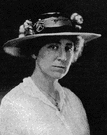The people of Montana elected Rankin in 1916, largely on a platform of women's voting rights. She took office on March 4, 1917. One of her first actions was to introduce a bill that would have allowed women citizenship independent of their husbands. One of her major acts as a member of the House of Representatives was to vote against war with Germany during World War I. (Fifty-six other members of Congress also voted against war.) This vote cost Rankin her seat in Congress because the majority of people in America at that time thought that Germany was to blame for the war.
Rankin, however, had found a new cause: antiwar. She served out her term in the House, then played a major part in the pacifist (anti-war) movement for the rest of her life. Among the many organizations that she belonged to were the Women's International League for Peace and Freedom and the National Council for the Prevention of War. During World War II, the cause of peace was again being advanced. Rankin ran for Congress again, in 1940, and was elected again. And when America declared war on Japan after the bombing of Pearl Harbor in 1941, Rankin was the only member of Congress (House or Senate) to vote against war. She was not re-elected that time, either, and spent the rest of her life pursuing peace. She went to India to study the nonviolent protest methods of the great Hindu leader Mohandas Gandhi. She led marches against America's participation in the Vietnam War. In fact, Rankin led a 5,000-woman-strong antiwar march in Washington, D.C., in 1968, when she was 87. |
|
Social Studies for Kids
copyright 2002–2025
David White



